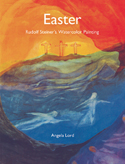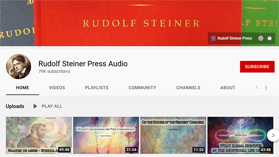
-
EASTER
Rudolf Steiner's Watercolor Painting
Angela Lord

This marvellous book explores the deep meaning of the watercolour Easter (or "Three Crosses") painted by Rudolf Steiner in April 1924. Living through this book into Steiner's watercolour painting, the reader is led to contemplate the profound mysteries of not only colours and the sense world, but also the divine, cosmic, human invisible reality lying behind them and manifested in the unique event we celebrate as Easter.
At first, the colouring and composition of the painting seem relatively simple. But the longer one looks at and mediates upon it, questions begin to press upon the viewer:
· Why did Rudolf Steiner use the rainbow sequence of colours?
· Why are the crosses so small, seen only from a distance?
· Who or what are the white figures "below the earth"?
· What is the painting actually about?Answering these questions, artist Angela Lord draws on a wide range of anthroposophic and other sources to illuminate the enormous mystery of Easter itself. It becomes clear that in the painting, Steiner does not focus on Good Friday but on Holy Saturday and Jesus Christ's "descent into hell", or into Limbo, to raise the dead. Thus, the motif is not suffering so much as it is the germinating theme of Resurrection.
The author then turns to meditate on the painting in the light of the Twenty-third Psalm, and the reader recognizes the Psalmist's image of "comfort" in a new form. The book also considers the Easter verses in Steiner's Calendar of the Soul, as well as the pre-Christian Mystery of Adonis, which expands the reader's understanding of the colours and the profound meaning of the painting.
The author then turns to meditate on the painting in the light of the Twenty-third Psalm, and the reader recognizes the Psalmist's image of "comfort" in a new form. The book also considers the Easter verses in Steiner's Calendar of the Soul, as well as the pre-Christian Mystery of Adonis, which expands the reader's understanding of the colours and the profound meaning of the painting.
Lord then delves into the mysteries of colours as Steiner uses them - from the polarity of red and black, the contrast of orange and green, the radiance of yellow and blue, and the enigmatic presence of white and violet to an experience of the painting as a beautiful rainbow.
The Easter experience, as the colours teach, offers the "rainbow meditation" and what it means to be human. Moreover, because humanity is (in Steiner's words) "the religion of the gods," Angela Lord ends her book with an exploration of the cosmic meaning that shines through the colours.
Angela Lord is a painter, interior colour designer, muralist, and art educator. Born and educated in Christchurch, New Zealand, following seven years of teaching in state primary schools, she became a teacher of special needs children in a Rudolf Steiner curative education school (Hohepa), developing a program for crafts and painting therapy. She studied with Gerard Wagner and received a diploma from the Goetheanum Painting School, Dornach, Switzerland. With her partner Robert Lord, she began the Colour Transformation Company, which specializes in the Lazure painting technique, interior design, and murals. She also runs an open studio for watercolour painting, the Colour Research Studio, in East Sussex, England, and has given workshops and lectures on colour and art history in New Zealand and Europe. Her books include The Twelve Dancing Princesses; The White Snake (fairytales for children); Art, Aesthetics and Colour: Aristotle, Aquinas and Steiner; and Colour Dynamics: Workbook for Watercolour Painting and Colour Theory.
June 2011; SB; 80pp; 21 x 27cm; pb;
£22.50 ISBN 9780880107235 - This title is out of print.

